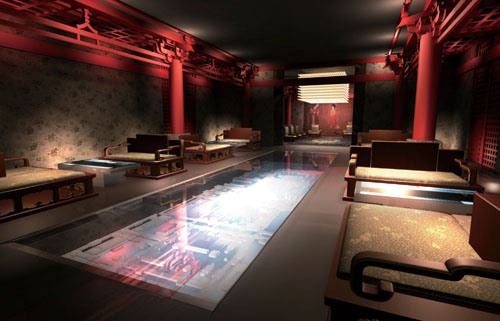|
New Industrial Model
The key to preservation and reconstruction of the ruins region is funding. Within the 3.2 square kilometers of the Daming Palace Ruins Region, 3.5 million square meters of buildings were dismantled, involving 100,000 inhabitants.
"Relocating 100,000 inhabitants cost RMB 8.4 billion. We want to improve the living standards of these citizens, and their new homes are not far from their old ones, so that they can benefit from the Ruins Park. After all, they have made a great sacrifice for the protection of the ruins," says Duan Xiannian. But this is only a small part of the project. The total renovated area will cover nearly 20 square kilometers. "The fund for preservation and reconstruction will amount to RMB 18 billion," adds Duan.
This is a huge sum compared to RMB 16 billion, the total revenue of Xi'an in 2009.
An important source of funding is big real estate developers. Duan Xiannian adopted the "reverse order." The government borrowed money to requisition land, make city planning and build infrastructure facilities. The prepared land is then auctioned off to recoup the funds. Their viewpoint is that the value of land lies in its environment, and the environment elevates industrial activity.
Before getting involved in the Daming Palace Ruins Region, Duan Xiannian had successfully conducted some large-scale cultural relic projects. His accumulated experience and fundraising skills have made the preservation and reconstruction project a reality.
"Many people have realized that historical splendor can stimulate cultural renaissance in commercial development, and reshape the city's culture. This is a new industrial model. Historical value increases through cultural renaissance," says Ren Xi'an, deputy director of the Xi'an Qujiang Daming Palace Ruins Region Preservation and Reconstruction Office.
Seamless History and Modernity
As Daming Palace was the most luxurious palace in Chinese history, people are still debating aspects of the plan.
"To preserve the integrity of the site, no reconstruction is allowed within the ruins region, because the archaeological work has not yet been completed. Archaeological excavation must be considered in construction," says Zhang Jinqiu, chief architect of Danfeng Gate, the main entrance of the Daming Palace.
Except for some underground ruins that are in excavation, the buildings above ground were destroyed in the 10th-century warfare. Even the debris was damaged in the later years, leaving only some foundations and rammed earth strata.
 |
|
The Daming Palace was the center of politics, economics and culture during the Tang Dynasty. In the 280 years of its existence, the Daming Palace functioned as the hub of international communication at that time. More than 17 emperors have lived and presided over government affairs in the palace.
|
"On one hand, we hope the ruins of the Daming Palace can reflect the splendor of the Tang Dynasty; on the other, we hope the ruins will be an attractive spectacle in a modern Xi'an and a part of the city life," says Ren Xi'an.
Danfeng Gate, built at the cost of RMB 130 million, literally links modernity with ancient times. Zhang Jinqiu, who has been engaged in research and design of Tang-style architecture for 30 years, holds that ancient architecture should be blended into the city's existing environment and layout.
"The scale, measurements and shape of Danfeng Gate are built in strict Tang style," says Zhang Jinqiu. Actually, the reconstructed Danfeng Gate is a museum built on the site of the Tang Dynasty Danfeng Gate. Visitors have a panoramic view of its archaeological excavation. To protect the ruins, the new building stands 0.6 meters from the ruins, and can be dismantled easily when archaeological excavation needs.
The design of the palace is to add a two-meter-thick layer of earth on the foundation of the rammed earth. Based on this, some removable steel structures can be put up to show the palace's structure, and on this platform trees and grass can be planted to indicate Tang traces.
The Daming Palace Ruins Region is more like a "green lung" for Xi'an, with its green area exceeding 70 percent. The park administrator hopes that it can play a role similar to Central Park in New York City, alleviating the city's hot island effect, lowering temperatures, removing dust and filtering the air.
"The Daming Palace is an exemplary building and a landmark of Chinese history; it has huge economic value that will become evident in the future. We can be proud of the Daming Palace Ruins Region as a Chinese model and an Oriental model for the protection of cultural heritage," concludes Giora Solar.
Editor: Xie Fang
Source: China Today
|

